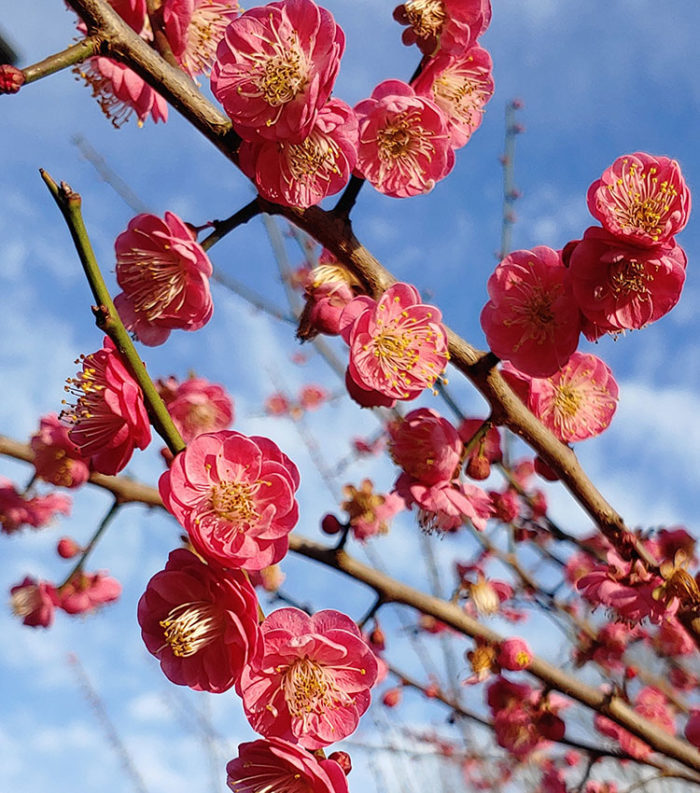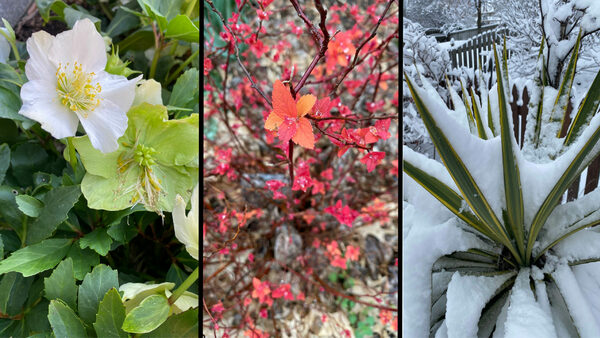
Here in the Southeast we always have something blooming, even in the poorly named “dead” of winter. Don’t think so? Just pay a bit more attention the next time you are a passenger in a ride around your neighborhood and I bet you’ll be surprised. If you’re still building up your repertoire of plants, you might even be a little confused. You’ll spot some familiar spring colors in January or February and wonder, “Why is the forsythia blooming so early?” or “What is that cherry tree doing in full bloom now?” While some of our winters do result in early bloom, it’s more likely that you’re experiencing cases of mistaken plant identity. Rather than disappointments, these are happy accidents resulting in new plant discoveries and opportunities, sometimes obsessions. Here are three such plants that once fooled me with their seeming familiarity but puzzling heart-of-winter bloom time. I now call them favorites, and they remind me to keep looking for more surprises.
Winter Jasmine

Mistaken for forsythia (Forsythia spp. and cvs., Zones 4–9), winter jasmine (Jasminum nudiflorum, Zones 6–9) has a profusion of golden yellow blooms, making it impossible to overlook in the winter landscape. Just as the holiday lights are being packed away, winter jasmine turns on. The color, shape, and abundance of flowers on 3-to-4-foot mounding shrubs (unless the shrubs are trained to grow on a trellis) are dead ringers for forsythia flowers from a distance. Get a little closer and the differences come into focus; winter jasmine’s square green stems, trifoliate leaves (evergreen in the lower Southeast), arching habit, and flowers with more than the four petals of forsythia reveal its true identity. Winter jasmine is tough and trouble-free, grows in sun to partial shade, and is practically a Southern garden heirloom. Such an easy plant that seems to bring rays of yellow sunshine is welcome in any landscape or garden in winter.
Japanese Apricot

Delicate blooms in shades of pink adorning a small tree—a flowering cherry in January? Well, yes and no. Japanese flowering apricot (Prunus mume, Zones 6–9), also called plum blossom is, in fact, in the same genus as cherry (Prunus spp. and cvs., Zones 3–9). The similarities are apparent, yet Japanese apricot is its own kind of wonderful. From a distance, the glow of clear pink lifts spirits, but true enchantment occurs when one is face-to-face with the elegant, perfectly formed, iconic flowers. As with many other winter bloomers, move in close and you’ll be surprised by a swoon-worthy, unique perfume. Fragrances range from delicately sweet to spicy cinnamon or clove, depending on the cultivar.
Christmas Rose

Christmas rose (Helleborus niger, Zones 3–8) is a close cousin to the more common, and equally un-rose-like Lenten rose (Helleborus orientalis, Zones 4–9). The difference in bloom time is right there in the names, although neither of these shade-loving perennials is a slave to the calendar. Christmas rose does come first, though—anytime from late December to February in the Southeast. Its pure white blooms, eventually aging with tinges of rose pink, are bright and bracing against divided dark evergreen foliage. Despite a height of no more than 10 inches, Christmas rose is a sturdy plant that holds its flowers up and out, unlike the nodding blooms of Lenten rose. It’s a slower grower, and I’ve never had seedlings from it (unlike Lenten rose), but I wouldn’t be without it. Neither would the plant breeders, as its genetics are in many of the bold new hybrid hellebores with outward-facing blooms. As the earliest-blooming hellebore, it deserves a special spot near the house where it can work its magic—magic that in part begins with questions and continues with conversations about curiosity and looking more carefully, about diversity and abundance, and about the delight of mistaken identities.
—Paula Gross is the former assistant director of the University of North Carolina at Charlotte Botanical Gardens.


















Comments
Log in or create an account to post a comment.
Sign up Log in